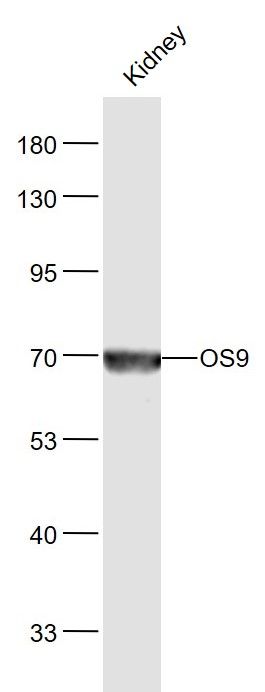OS9 Polyclonal Antibody
Purified Rabbit Polyclonal Antibody (Pab)
- SPECIFICATION
- CITATIONS
- PROTOCOLS
- BACKGROUND

Application
| WB, IHC-P, IHC-F, IF, E |
|---|---|
| Primary Accession | Q13438 |
| Reactivity | Rat, Dog, Bovine |
| Host | Rabbit |
| Clonality | Polyclonal |
| Calculated MW | 76 KDa |
| Physical State | Liquid |
| Immunogen | KLH conjugated synthetic peptide derived from human OS9 |
| Epitope Specificity | 101-200/667 |
| Isotype | IgG |
| Purity | affinity purified by Protein A |
| Buffer | 0.01M TBS (pH7.4) with 1% BSA, 0.02% Proclin300 and 50% Glycerol. |
| SUBCELLULAR LOCATION | ndoplasmic reticulum lumen. |
| SIMILARITY | Belongs to the OS-9 family. Contains 1 PRKCSH domain. |
| SUBUNIT | Probably part of the HRD1 ubiquitin ligase complex composed at least of SYVN1/HRD1 and SEL1L with which it interacts directly. Through this complex it may interact with ERLEC1 and HSPA5. Interacts with DERL2. Interacts with HSP90B1 and CREB3. |
| Post-translational modifications | Intramolecular disulfide bonds. Isoform 1 and isoform 2 are N-glycosylated. |
| Important Note | This product as supplied is intended for research use only, not for use in human, therapeutic or diagnostic applications. |
| Background Descriptions | Lectin which functions in endoplasmic reticulum (ER) quality control and ER-associated degradation (ERAD). May bind terminally misfolded non-glycosylated proteins as well as improperly folded glycoproteins, retain them in the ER, and possibly transfer them to the ubiquitination machinery and promote their degradation. Possible targets include TRPV4. |
| Gene ID | 10956 |
|---|---|
| Other Names | Protein OS-9, Amplified in osteosarcoma 9, OS9 |
| Target/Specificity | Ubiquitously expressed. Found as well in all tumor cell lines analyzed, amplified in sarcomas. Highly expressed in osteosarcoma SJSA-1 and rhabdomyosarcoma Rh30 cell lines. Isoform 2 is the major isoform detected in all cell types examined. |
| Dilution | WB=1:500-2000,IHC-P=1:100-500,IHC-F=1:100-500,IF=1:100-500,ELISA=1:5000-10000 |
| Format | 0.01M TBS(pH7.4), 0.09% (W/V) sodium azide and 50% Glyce |
| Storage | Store at -20 ℃ for one year. Avoid repeated freeze/thaw cycles. When reconstituted in sterile pH 7.4 0.01M PBS or diluent of antibody the antibody is stable for at least two weeks at 2-4 ℃. |
| Name | OS9 |
|---|---|
| Function | Lectin component of the HRD1 complex, which functions in endoplasmic reticulum (ER) quality control and ER-associated degradation (ERAD) (PubMed:18264092, PubMed:18417469, PubMed:19084021, PubMed:19346256, PubMed:21172656, PubMed:24899641). Specifically recognizes and binds improperly folded glycoproteins as well as hyperglycosylated proteins, retain them in the ER, and transfers them to the ubiquitination machinery and promote their degradation (PubMed:18264092, PubMed:18417469, PubMed:19084021, PubMed:19346256, PubMed:21172656, PubMed:24899641). Possible targets include TRPV4 as well as hyperglycosylated HSP90B1 (PubMed:17932042). |
| Cellular Location | Endoplasmic reticulum lumen |
| Tissue Location | Ubiquitously expressed (PubMed:8634085). Found as well in all tumor cell lines analyzed, amplified in sarcomas (PubMed:8634085). Highly expressed in osteosarcoma SJSA-1 and rhabdomyosarcoma Rh30 cell lines (PubMed:8634085) |

Thousands of laboratories across the world have published research that depended on the performance of antibodies from Abcepta to advance their research. Check out links to articles that cite our products in major peer-reviewed journals, organized by research category.
info@abcepta.com, and receive a free "I Love Antibodies" mug.
Provided below are standard protocols that you may find useful for product applications.
If you have used an Abcepta product and would like to share how it has performed, please click on the "Submit Review" button and provide the requested information. Our staff will examine and post your review and contact you if needed.
If you have any additional inquiries please email technical services at tech@abcepta.com.













 Foundational characteristics of cancer include proliferation, angiogenesis, migration, evasion of apoptosis, and cellular immortality. Find key markers for these cellular processes and antibodies to detect them.
Foundational characteristics of cancer include proliferation, angiogenesis, migration, evasion of apoptosis, and cellular immortality. Find key markers for these cellular processes and antibodies to detect them. The SUMOplot™ Analysis Program predicts and scores sumoylation sites in your protein. SUMOylation is a post-translational modification involved in various cellular processes, such as nuclear-cytosolic transport, transcriptional regulation, apoptosis, protein stability, response to stress, and progression through the cell cycle.
The SUMOplot™ Analysis Program predicts and scores sumoylation sites in your protein. SUMOylation is a post-translational modification involved in various cellular processes, such as nuclear-cytosolic transport, transcriptional regulation, apoptosis, protein stability, response to stress, and progression through the cell cycle. The Autophagy Receptor Motif Plotter predicts and scores autophagy receptor binding sites in your protein. Identifying proteins connected to this pathway is critical to understanding the role of autophagy in physiological as well as pathological processes such as development, differentiation, neurodegenerative diseases, stress, infection, and cancer.
The Autophagy Receptor Motif Plotter predicts and scores autophagy receptor binding sites in your protein. Identifying proteins connected to this pathway is critical to understanding the role of autophagy in physiological as well as pathological processes such as development, differentiation, neurodegenerative diseases, stress, infection, and cancer.


